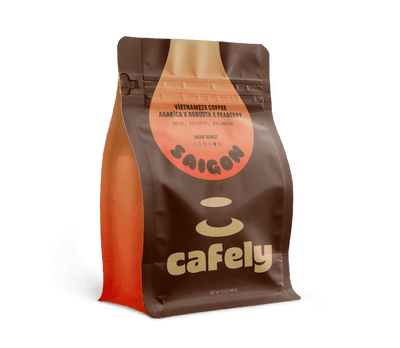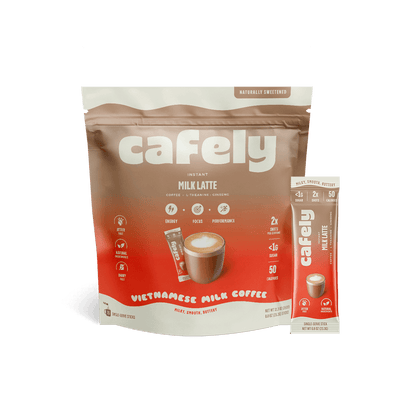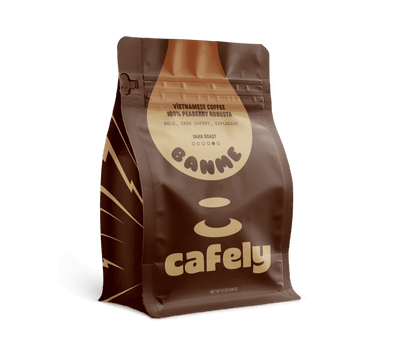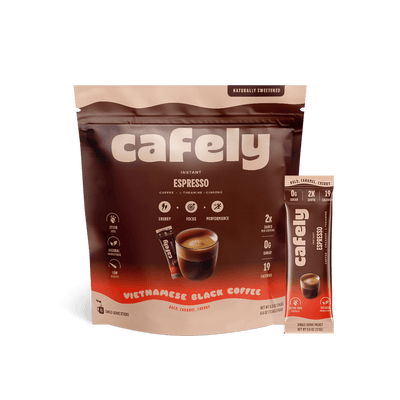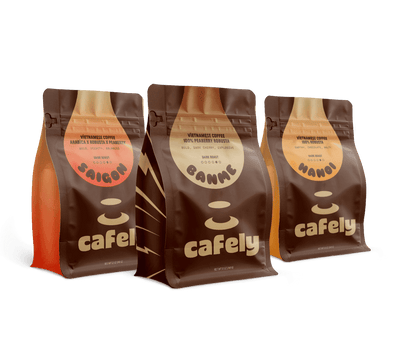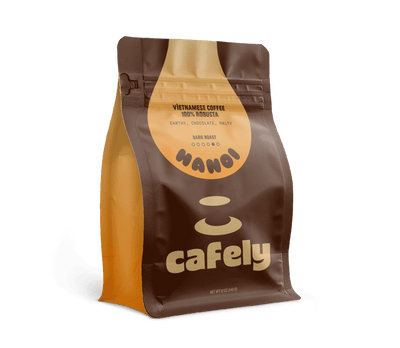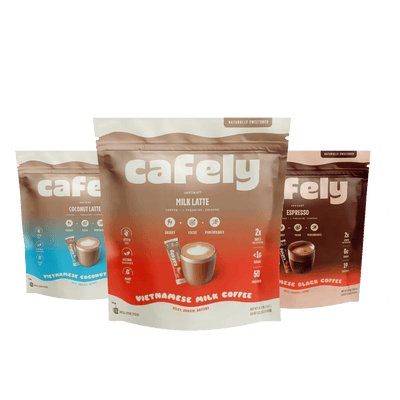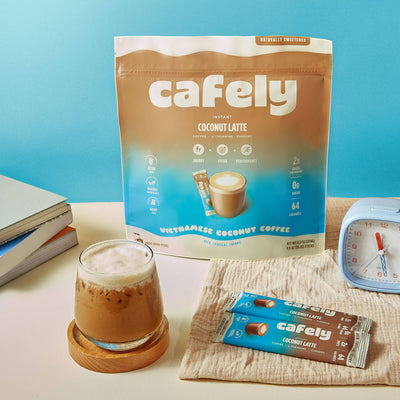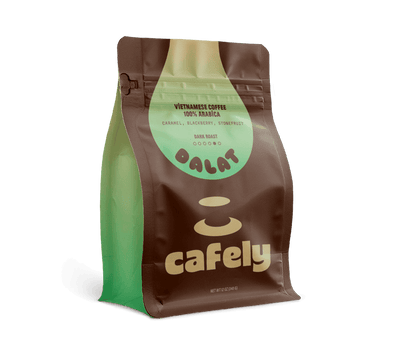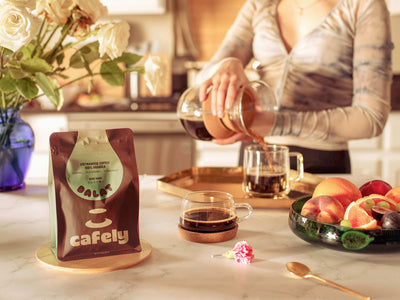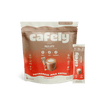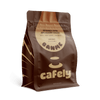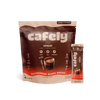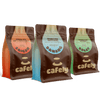A serving of iced coffee typically contains 60 mg to 200 mg of caffeine. However, some brews made with high-strength coffee syrup can contain up to 400 mg of caffeine — Dunkin’ Donuts iced coffee, for example.
The exact amount of caffeine in a glass of iced coffee depends on how it's made and whether coffee arabica is used in its creation, or a blend of robusta beans.
In this guide, we look at the caffeine levels in different types of iced coffee, how strength differs depending on bean type, and how to craft a high-strength iced coffee at home.
The Caffeine in Iced Coffee
The caffeine content in iced coffee varies depending on the brewing method, coffee-to-water ratio, and the type of beans used.
Arabica beans such as DaLat tend to have a smoother, sweeter taste and lower caffeine content, while robusta beans such as HaNoi blend are more bitter but contain nearly twice as much caffeine. Some iced coffee beverages are made with espresso machine, while others use drip coffee, French press, instant coffee, or even cold brew.
Here's how the caffeine levels of iced coffee differ between brewing methods and bean types:
1. Caffeine in Iced Coffee Made With Espresso

Espresso-based iced coffee is made by pulling a single or double shot of espresso, cooling it, pouring it over ice, and combining it with milk and (often) syrup to sweeten. Espresso iced coffee may also be made with water instead of milk to create an iced Americano coffee.
A typical 8 oz (240 mL) serving of espresso iced coffee made with a single shot contains 63 to 80 mg of caffeine. An iced coffee made with a double shot can contain anywhere from 100 to 160 mg of caffeine.
The amount of caffeine in espresso iced coffee varies depending on what type of beans are used.
Here are the rough caffeine levels in an 8 oz single shot espresso iced coffee made with arabica, robusta, or a blend of both beans:
- Arabica: 63–80 mg
- Robusta: 120–160 mg
- Blend (Arabica & Robusta): 80–140 mg
2. Caffeine in Iced Coffee Made With Drip Coffee

Drip coffee is made using an automatic drip coffee maker, which heats water and slowly pours it over ground coffee. The brew then passes through a filter and is collected in a carafe below.
Iced coffee is made with drip coffee by increasing the coffee-to-water ratio to create a concentrated shot. This shot is then cooled to room temperature, poured over ice, and diluted with milk or water.
The typical 8-oz (240 mL) serving of drip iced coffee contains 95 to 165 mg of caffeine. The exact caffeine level varies depending on the coffee-to-water ratio used and the type of beans.
Here are the rough caffeine levels in an 8-oz cup of drip iced coffee made with arabica, robusta, and blends:
- Arabica: 95–120 mg
- Robusta: 140–220 mg
- Blend (Arabica & Robusta): 100–160 mg
3. Caffeine in Iced Coffee Made With a French Press

Making iced coffee with a French press is one of the simplest ways to make barista-level iced coffee at home.
Iced coffee is made this way by brewing a concentrated coffee in a French press by increasing the coffee-to-water ratio. The concentrated brew is then poured over ice, diluted with milk or water, and sweetened with sugar or syrup.
An 8-oz (240 mL) serving of French press iced coffee contains between 110 and 175 mg of caffeine. However, the bean type and coffee-to-water ratio can affect the exact content.
Here are the caffeine levels in an 8-oz glass of French press coffee made with different beans:
- Arabica: 110–130 mg
- Robusta: 150–220 mg
- Blend (Arabica & Robusta): 120–175 mg
4. Caffeine in Iced Coffee Made With Instant Coffee

Using instant coffee is the easiest and quickest way to make iced coffee. Although it won’t produce as good a brew as other methods on this list, the strong, dark, bitter flavors of instant coffee work well in a chilled milk beverage.
Iced coffee is made with instant coffee by adding a sachet or a tablespoon of instant coffee granules to 60 to 100 mL of hot water. The concentrated coffee is then sweetened with sugar or syrup (optional), cooled, poured over ice, and diluted with milk.
The typical 8 oz serving of instant iced coffee contains 30 to 150 mg of caffeine. The exact level varies depending on the brand used. Robusta blends, such as our Vietnamese Instant Espresso, can produce iced coffee with more than 150 mg of caffeine per serving.
5. Caffeine in Vietnamese Iced Coffee

Vietnamese iced coffee (cà phê sữa đá) is a deliciously sweet and creamy brew from Vietnam. It’s made using Vietnamese robusta coffee that’s been prepared using a traditional phin drip filter.
The bold, dark, bitter flavors of robusta are mellowed out with sweetened condensed milk, and the drink is chilled with ice. Robusta coffee beans are renowned for their strength — producing twice as much caffeine as arabica beans.
An 8 oz (240 mL) glass of Vietnamese iced coffee contains 165 to 240 mg of caffeine. The exact level can vary depending on the coffee-to-water and coffee-to-milk ratios used.
6. Caffeine in Cold Brew Coffee

Cold brew coffee is made differently from regular iced coffee. Rather than brewing coffee with hot water, cooling it, and diluting it, cold brew is steeped with cold water for 18 to 24 hours. This process extracts more caffeine from the beans than typical hot-brewing methods, resulting in a stronger brew with lower acidity.
Cold brew coffee is usually made with a French press. Coarse-ground coffee is steeped in fresh, filtered, cold water overnight in a refrigerator. Then, the grounds are separated by pushing the plunger through the brew.
Cold brew coffee is typically consumed undiluted, without milk or sugar. However, a concentrated cold brew can also be used to create iced coffee with a higher caffeine content and lower acidity.
A typical 8-oz (240 mL) glass of cold brew coffee contains 150 to 250 mg of caffeine.
The exact caffeine content varies depending on the bean type used:
- Arabica: 150–180 mg
- Robusta: 220–280 mg
- Blend (Arabica & Robusta): 170–220 mg
How Much Caffeine Is Considered Safe?
The FDA recommends a maximum daily caffeine intake of 400 mg. Staying below this limit is considered safe for healthy adults.
Pregnant women or people with high blood pressure, heart conditions, or caffeine sensitivity should avoid caffeine entirely or reduce their intake drastically (less than 100 mg).
For healthy adults without ailments, this FDA limit allows:
- 4–5 servings of regular iced coffee
- 2–3 servings of cold brew coffee
- 5–6 servings of instant coffee
- 3–5 servings of drip coffee
- 5–6 single shots of espresso
- How to Make Strong Iced Coffee: High-Caffeine Recipe
Making strong iced coffee at home is easy. With the right coffee and brewing equipment, it’s possible to make an eight-ounce (240 mL) serving of iced coffee with up to 200 mg of caffeine.
Follow this guide to make a super-strong iced coffee at home:
Equipment:
- Moka Pot — This small stove-top brewer is capable of creating strong, concentrated, espresso-like coffee.
- Coffee Grinder — The best, strongest coffee is made with whole beans. The moka pot requires a fine grind — a burr grinder is the best way to achieve this.
- Coffee Measure — You'll need a coffee measure or weighing scale to portion your coffee accurately.
- Coffee Mug — A coffee mug is needed to cool the coffee shot.
- Large Serving Glass — Use a large serving glass to assemble and serve the iced coffee.
Ingredients:
- Robusta Coffee — 100% whole-bean robusta coffee is essential if you want to make a strong glass of iced coffee. These beans contain twice the amount of caffeine that arabica does.
- Water — Use fresh, filtered water to brew your coffee.
- Ice — You’ll need plenty of ice for this recipe.
- Milk — Opt for whole milk or a vegan plant-based alternative such as oat milk, almond milk, or soy milk.
- Sugar of Syrup (Optional) — Add a spoon of granulated sugar or coffee syrup to sweeten your brew if desired.
Coffee Recommendations
If you want to make the strongest iced coffee possible, you should opt for 100% robusta coffee. Robusta has around twice the amount of caffeine as arabica coffee.
We recommend a 100% peaberry robusta such as BanMe for creating strong, dark, bold iced coffee. By using this coffee and following the recipe below, you can create an iced brew with up to 200 mg of caffeine (per 240 mL serving).
If you want to create a similarly strong brew with less intensity, opt for a balanced blend of arabica and robusta, such as Saigon OG. Blends like this contain slightly less caffeine than 100% robusta but offer the sweet, smoothness of arabica.
By using Saigon OG and following the recipe below, you can create an iced coffee with up to 150 mg of caffeine (per 240 mL serving).
1. Measure and Grind the Coffee

First, you'll need to measure and grind the coffee. For a single serving of strong iced coffee, you'll need to produce a double shot of coffee with your moka pot. This requires 18 to 20 grams of coffee, depending on the size of the basket on your two-cup moka pot.
Grind the coffee to a fine grind — similar in consistency to granulated sugar or fine sand. A burr grinder is the best type of coffee grinder for achieving this consistency, but a blade grinder will also work.
2. Prepare the Moka Pot

Fill the bottom chamber (water reservoir) of your moka pot with water to the fill line. Then, insert the filter basket into the bottom chamber and fill it with your ground coffee.
Screw the top chamber (collection pot) to the bottom chamber, and then place the moka pot on your stove.
3. Wait for the Pot to Start Brewing

Turn your stove to a medium heat and wait for the pot to start brewing — this can be distinguished as a “gurgling” noise. This can take anywhere from two to 10 minutes.
4. Reduce the Heat

Once you hear the pot begin to brew (gurgling), reduce the heat to the lowest setting — this prevents scorching or over-extraction.
When the pot starts making a “hollow” noise and sputtering loudly, switch off the heat.
5. Cool the Shot

Pour your concentrated coffee shot into a small coffee mug and allow it to cool to room temperature. This usually takes 20 to 30 minutes. If you want to speed up the process, place an ice cube in the cup.
Note: If you want to sweeten your iced coffee with granulated sugar, add it to the shot while it’s warm and stir. This will ensure the sugar completely dissolves.
6. Assemble the Iced Coffee

In a large serving glass, add ice followed by your coffee. Fill the rest of the glass up with whole milk or a vegan alternative and stir to combine. Add syrup (if desired) and enjoy while cold.
FAQs: Caffeine in Iced Coffee
Want to learn more about the caffeine levels in iced coffee and other beverages?
Read through the answers to the frequently asked questions below.
1. What’s the Strongest Type of Iced Coffee?
The strongest type of iced coffee (other than that detailed in the recipe above) is Vietnamese iced coffee (cà phê sữa đá). This beverage is made by brewing dark roast robusta coffee with a traditional phin filter. The strong, rich brew is typically combined with high-quality condensed milk and served over ice.
2. What’s the Strongest Iced Coffee From Starbucks?
The strongest chilled beverage from Starbucks is the Nitro Cold Brew — with 280 mg of caffeine (grande).
3. What’s the Strongest Iced Coffee From Dunkin’ Donuts?
The strongest iced coffee from Dunkin’ Donuts is the brand’s regular iced coffee. A large Dunkin’ iced coffee (32 oz) contains a staggering 469 mg of caffeine.
4. What Has More Caffeine — Cold Brew or Iced Coffee?
Coffees for cold brew coffee typically contain more caffeine than iced coffee. The prolonged cold extraction process dissolves more caffeine, resulting in a stronger brew with less acidity.
5. How Much Caffeine in a Shot of Espresso?
The average single shot of espresso contains around 75 mg of caffeine, and a double contains 130 to 150 mg. However, espresso made with robusta or coffee blends can be significantly stronger — up to 140 mg per single shot.
6. Can You Make Iced Coffee With a French Press?

Yes. You can make delicious and strong iced coffee with a French press. Simply brew a concentrated coffee by increasing the coffee-to-water ratio and brewing as normal. Then, cool the coffee, pour it over ice, and dilute it with milk.
7. What’s the Strongest Type of Coffee Bean?
The strongest coffee bean is robusta. It’s around twice as strong as arabica and contains around 2.2% to 2.7% caffeine by weight (one gram contains 22 to 27 mg of caffeine).
8. What’s the Strongest Type of Coffee Drink?
The strongest coffee beverage by volume is the ristretto. The ristretto is an espresso that’s “restricted” by decreasing the extraction time. This results in a shot of coffee with the same amount of caffeine as espresso but around two-thirds the volume of water.
9. Does Coffee Have More Caffeine Than Tea?
Yes. Coffee contains more caffeine than tea. The average 8 oz (240 mL) cup of drip coffee contains 90 to 120 mg of caffeine. The average 8 oz cup of black tea contains around 40 to 70 mg of caffeine.
10. What’s the Best Coffee for Making Iced Coffee?
The best coffee for making iced coffee should be freshly ground from high-quality whole beans. Which type of coffee is “best” depends on personal preference. Opt for 100% robusta for a strong, dark, bold iced coffee. Select a 100% arabica for a mild, naturally sweet iced coffee. Choose a blend of both beans for a balanced iced coffee.



